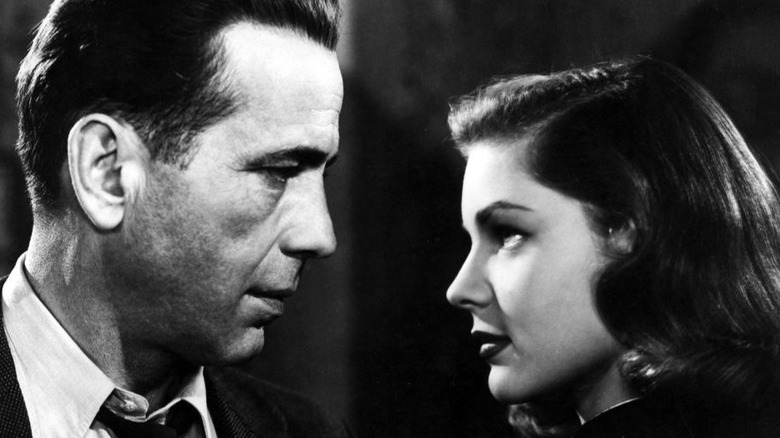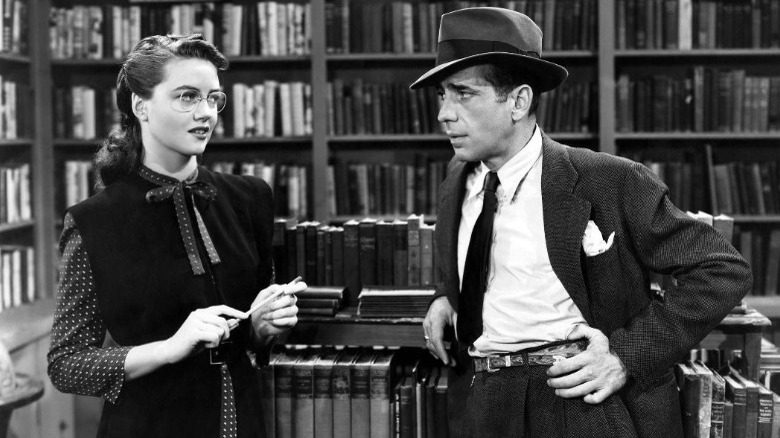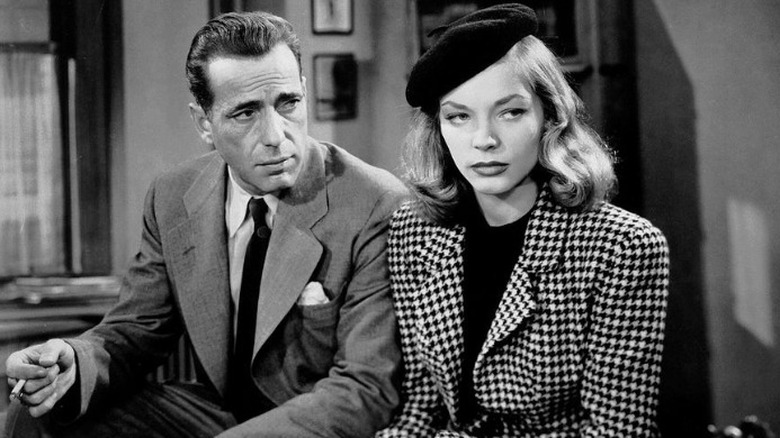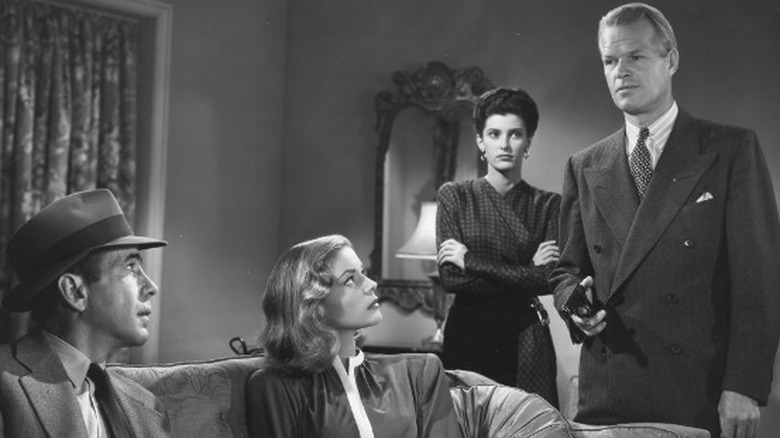No One Behind The Scenes Of The Big Sleep Understood The Story
Howard Hawks' 1946 adaptation of "The Big Sleep" is one of the best Humphrey Bogart movies. It's a great detective movie, following private eye Philip Marlowe (Bogart) as he investigates a blackmail case surrounding wild-child socialite Carmen Sternwood (Martha Vickers) on the instruction of her elderly father, General Sternwood (Charles Waldron). The General also wants Marlowe's help finding his missing companion, Sean Regan. When Carmen's widowed older sister Vivian (Lauren Bacall) attempts to throw him off the case, Marlowe begins to learn how deep the rabbit hole goes. The questions pile up, and the answers come quick, but "The Big Sleep" is not a mystery movie in a traditional sense. If it was, everyone behind the scenes might have understood more of the story.
Director Howard Hawks would claim in Peter Bogdanovich's interview book "Who The Devil Made It" that the movie was made with simple instructions from Warner Bros. head Jack Warner: After Hawks' 1944 film "To Have and Have Not," starring Bogart and Lauren Bacall, Warner wanted another movie with the two actors, something to capitalize on their unique chemistry. After the screening, Hawks mentioned a Raymond Chandler detective novel could work. "The next day," Hawks said, "I bought the screen rights to 'The Big Sleep.'" A number of difficulties fogged up the plot — the book was incredibly complex and dealt with grimy, sexual themes that could never get past Hollywood censors. It also had mysteries to which nobody on-set had the answers.
Censoring Raymond Chandler
As director Howard Hawks relayed in "Who The Devil Made It," he informed writers William Faulkner and Leigh Brackett to not "monkey with the book." In Hawks' opinion, Chandler's writing was simply too good, and "The Big Sleep" was a classically hard-boiled and witty mystery buried in sun-drenched Los Angeles depravity, told by iconic detective character Philip Marlowe. "The Big Sleep" features no voice-over, but Hawks' direction visually conveys the book's ideas.
Certain alterations were necessary in the transition. The same Hollywood censorship guidelines that got "Some Like It Hot" banned in Kansas led to significant changes in the adaptation of "The Big Sleep." The book dealt with some unsavory themes — Carmen Sternwood was more explicitly a "nymphomaniac" blackmailed for dirty pictures, and Vivian was married to "Rusty" Regan, who became Sean — a different character entirely. The blackmailer, Arthur Gywnn Geiger, owns an illicit pornography store, and is gay — his lover (Tommy Rafferty) in the book is reduced to simply his driver in the movie, which complicates his motivation when he kills extortionist Joe Brody (Louis Jean Haydt) as revenge for Geiger's death.
All in all, the movie keeps a lot of details in place, but the alterations made to appease censors add a fog of innuendo around the novel's complex plot, making it much harder to follow (if you're someone who cares about solving it).
The murdered chauffeur
There's an answer for every killing in the movie — all except one.
When blackmailing pornographer Gwynn Geiger is killed, Marlowe finds Carmen "high as a kite" in the man's bungalow, rented from gangster Eddie Mars (John Ridgely). He takes her home and later on, Geiger's driver, Carol Lundgren, suspects gangster Joe Brody, and shoots him. It turns out that Geiger's killer was actually Owen Taylor, the Sternwood chauffeur, who was killed later that night. But who killed Owen Taylor?
This mystery above all continued to vex Howard Hawks and the cast throughout the movie. According to A.M. Sperber and Eric Lax' biography "Bogart," the actor and the director would debate the murder during the movie's extensive filming process, getting so swept up in it that they decided to send a memo to Raymond Chandler himself asking who did it, whether it was a murder or a suicide. In a letter sent by Chandler years later, he said, "Dammit, I didn't know either." The vast network of mysteries created by the author was enough to elude him.
His question about Taylor's murder notwithstanding, Hawks kept his focus on getting the movie made according to his ethos, using which he summed up in "Who the Devil Made It." "You don't really have to have an explanation for things. As long as you have good scenes you have a good picture." He had a penchant for improvisation too, bolstered by contributions from writer Leigh Brackett (who wrote the original draft for "The Empire Strikes Back," another movie with some key improvised scenes).
Confusion became the goal
The answers come quick in "The Big Sleep," as the movie builds up to dramatic confrontations in lovingly furnished apartments with multiple parties holding onto secrets and handguns. Howard Hawks cared more about getting the feeling of an investigation right than giving the audience a clear mystery with clear answers. Because the movie follows Marlowe down the rabbit hole, every scene begins and ends with Humphrey Bogart. As Hawks said in "Who the Devil Made It," "there are only a few actors in the world you can have in every scene and not get tired of them." Bogart had already made a huge impression in film noir with 1941's "The Maltese Falcon." Here, he did it again.
While filming, Bogart was less than available. According to A.M. Sperber and Eric Lax' biography "Bogart," filming was stalled by weather and calamitous moods from the actor, who, in the midst of divorce, pursued romance with Lauren Bacall. In "Bogart" it's claimed that writer Leigh Brackett rewrote on the day to drive the movie to its climax faster, further confusing the story and deviating from the course of the book.
After completion of the film in 1945, Warner Bros. held it in their backlog temporarily, which gave Hawks the chance to add new scenes. Rather than shoot scenes for the sake of clarity, the director added more scenes of Bogart and Bacall flirting. Comparing the cuts reveals his priorities: any scene that stops to explain the mystery is removed. If he and the cast were going to be confused behind the scenes and still make a good movie, the audience could enjoy it if they were confused too.



